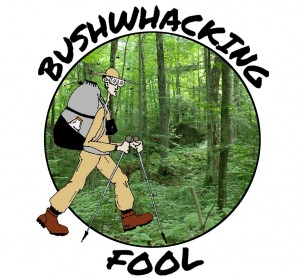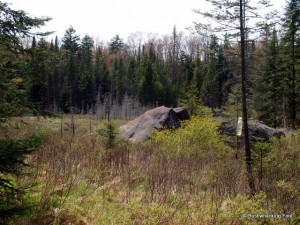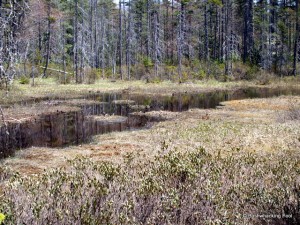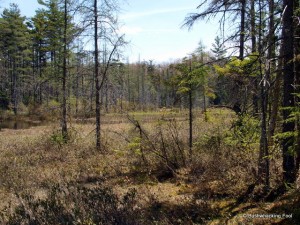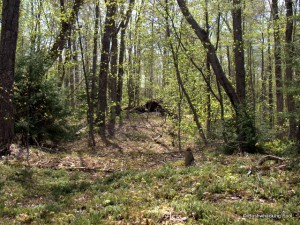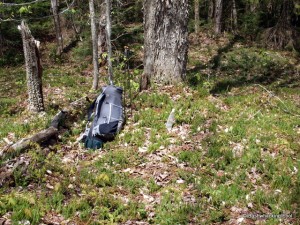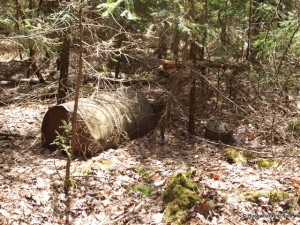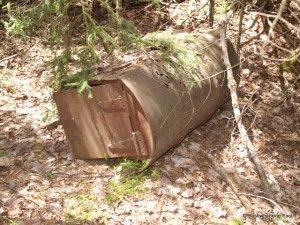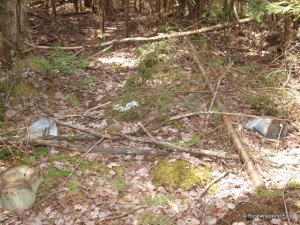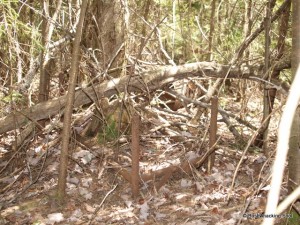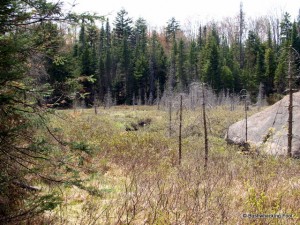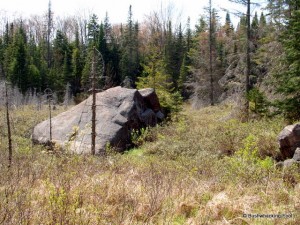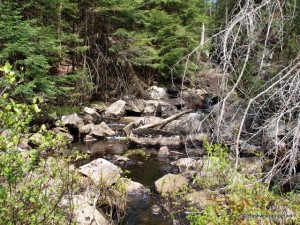The worst thing about crossing a beaver dam in the Adirondacks is that sometimes you just do not know what you are going to find on the other end. Sometimes the conditions are obvious from the other side, but often it is not. This is the case when I cross a beaver dam (point #13 on the accompanying map) on my way from Cropsey Pond to the Deer Pond outlet during my foray into a Birdathon in the Pepperbox Wilderness for the first time in two years.
The thick coniferous trees on the other side of the beaver dam makes reentering the forest difficult, and the short but shear rock cliffs did not help either. Luckily, I find a way to avoid the steepest climb, but I keep reminding myself to tripod (i.e. keep at least three of my four anchors on the ground, counting my two feet and both homemade hiking poles) the entire time as I slip and slid my way up. Many boulders protruding from the forest floor further impede my progress after the steepest portion of the climb is behind me.
View Birdathon 2103: Day 2, Part 3 in a larger map
I take a 56-degree bearing with my compass, hoping to graze the edge of a boggy wetland before heading due north to the Deer Pond outlet stream. The forest is thick with fir trees, their branches slapping me in the face repeatedly, irritating the welt on my lip from the day before. I would rather get closer to the wetland off to the east, but the forest is so thick that I favor an easier path to the west.
Section Stats:
Date: May 18, 2013
Length: 1.8 miles (4.3 total daily miles; 6.0 total trip miles)
Difficulty: Moderate
By noon, I arrive at the shore of the small boggy wetland, mostly choked with herbaceous vegetation with only a narrow strip of open water meandering down its center. Although tempted to proceed eastward, where a more extensive wetland lies, the thickness of the forest convinces me to use my audio skills with birdcalls to add a few species to my list.
A Lincoln’s sparrow sings off to the southeast, making it this entire side trip worthwhile. I swear I hear an olive-sided flycatcher calling, but it never vocalizes again, so I fail to add it to my Birdathon list. A Nashville warbler sings off to the west, just before I start to leave. Yielding just a couple new species, the boggy wetland is a disappointment just as the slower birding afternoon hours begin.
Setting a new bearing of 5 degrees, I head off toward the Deer Pond outlet, first navigating westward around the small boggy pond. Lunch can wait a little while longer, thinking I still might make it all the way to Raven Lake’s western shore by nightfall.
The climbing starts immediately, quickly leaving the coniferous forest around the wetland behind and welcoming the easier hiking through hardwoods, such as red maple, American beech and striped maple. The forest remains consistent throughout the climb, which lasts about a tenth of a mile before a more gradual descent toward the Deer Pond outlet begins.
Soon after descending toward the Deer Pond outlet, I stop for lunch, my reasoning being that the black flies should be less abundant in this relatively dry upland situation. Unfortunately, no one told the horde hovering around my head of this, leaving me pitying those poor animals hanging around any streams. Like I soon will be.
Despite the ever-present insect horde, I sit down for a pleasant late lunch of a peanut butter and jelly sandwich. Even during lunch, I continue noticing avian species, as a blue-headed vireo, a winter wren and a black-throated blue warbler serenade me during my meal, with a dark-eyed junco providing some additional entertainment as it hops around on the forest floor. Perhaps the poor junco is merely waiting for me to depart, so it can pick up the crumbs l leave behind.
The blackflies keep me from lingering too long, as within a short time I continue my trek toward the Deer Pond outlet stream. Ignoring my compass, I make the mistake of descending into some dense spruce/fire bordering a small wetland to the west. What was I thinking? I hoped I could follow this wet area to the Deer Pond outlet, but the forest density had me soon trying to flee upslope as soon as I can work my way through the maze.
While trying to negotiate back eastward away from the wetland, I stumble over some discarded junk scattered throughout the trees. Looking around, I notice even more man-made debris, long abandoned, probably from an old hunters camp, or perhaps a loggers’ campsite. Two metal drums protrude from the forest floor, along with a couple metal buckets, a washtub and some broken but once ornate glassware. These people lived in style in their day! An old, rusted bed frame lies covered with dead branches, an old stump protruding from its center.
Pushing my way east through young coniferous trees, I eventually start to climb upslope, where red maples once again appear in the forest. A ruffed grouse flushes up nearby, startling me, nearly to the point of peeing. Fragments of bone lies shattered on the ground, apparently a predator’s attempt to strip it of its marrow.
When I climb far enough to meet the coniferous/hardwood border, I stay to the upslope/hardwood side where the bushwhacking is easier. Continuing northwards, I frequently cross through to conifers before returning to the hardwoods, roughly following what the map indicates is a small stream down to the west.
Bushwhacking farther, I see a large clearing to the northwest, soon followed by the sound of cascading water to the north. I descend a steep but short slope and emerge from the forest where the Deer Pond outlet stream enters what once probably was a large beaver pond, now mostly a shrub covered meadow, at least from my vantage point.
My position is near the southern tip of the meadow, which runs roughly north/south, with the stream entering in the southeast corner and exiting near the northwest corner. Several large boulders protrude from the shrubbery on the opposite side of the stream near the bend where the meadow turns north. My view of the meadow remains obstructed due to my position, but exploring further must wait while I attend to an immediate need.
The black fly horde converges on my head within minutes after my emergence, but unfortunately, my lack of drinking water makes it imperative that I filter some here. Typically, two liters is enough for a long day of bushwhacking, but my cold and constant nose blowing dehydrated me enough that I continuously sucked down water since leaving Cropsey Pond earlier this morning.
The stream is ideal for water filtering, as access is easy in the meadow, complete with a relatively dry shoreline. Large rocks lie strewn throughout the rushing water, which exits from a coniferous forest a short distance to the east. Farther upstream, I hear the sound of cascading water, apparently from a waterfall, which I catch a glimpse of through the surrounding forest.
I set up my gravity filter first, as it takes time to do its work. Since I brought the PurifiCup, an on-demand water filter, to test for an Adirondack Almanack article, I set it up too within the grassy area along the stream. The PurifiCup filters water quickly, at least this time, as it lacked an urgency last time during the Frostbite Overnight back in March.
After sucking down a few 8-ounce glasses of water from the PurifiCup, I suddenly found myself in the thrall of nature’s call. Grabbing my bag of toilet paper, I headed back into the forest, up the steep slope, leaving my filters and my backpack behind in the clearing. Unfortunately, the bulk of the blackflies stuck with me.
After taking care of business, I return to the site of my water filtering, and consume another few 8-ounces of water from the PurifiCup. Then I suddenly notice water accumulating between the filter element and the outer housing. My first reaction is, “Oh crap!” quickly followed by dumping the already filtered water back into the stream. Since the filter has no rubber seals, I thought for sure I probably ingested contaminated water, I could feel the giardia pathogens reproducing exponentially already. I guess if I come down with any post-trip aliments, I will know where it came from.
Now, all I had to do is wait for the filtering to finish, then it would be off to Deer Pond and beyond. How far beyond the pond looked in doubt, as the sun continues to descend toward the western horizon.
Affiliate Disclaimer: Some links within this blog post may send you to a retailer website. If you chose to purchase any product on that site at that time, this author receives a small commission. These commissions provide compensation for the author’s time and effort necessary to provide the content at the Bushwhacking Fool.
